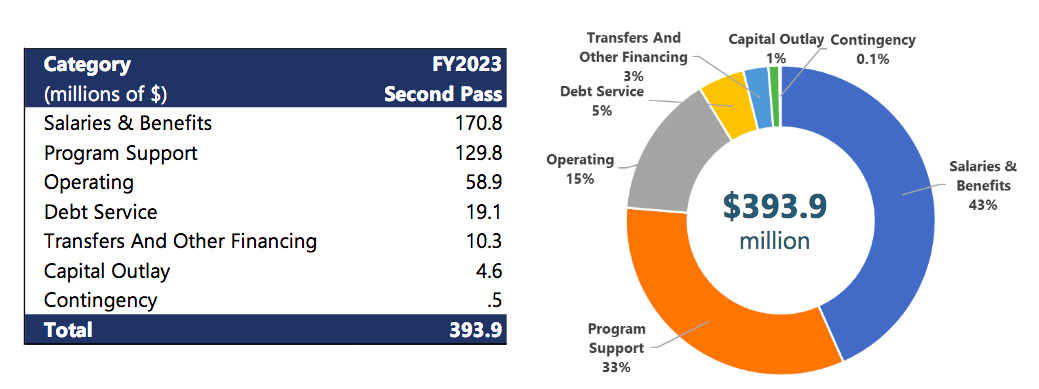As inflation continues to percolate through the U.S. economy — with the federal consumer price index, a standardized measure of costs for goods and services, rising by 8.5% from March 2021 to March 2022 — nearly everything is getting more expensive. That includes the government labor Buncombe County residents pay for through their taxes.
During the county Board of Commissioners’ April 26 work session, interim Budget Director John Hudson presented Buncombe’s current revenue and expenditure projections for the 2022-23 fiscal year. By far the biggest driver of spending growth, accounting for $14.6 million of a projected $20.4 million in new general fund expenses, is salaries and benefits. Total general fund spending on employees is estimated at $170.8 million, over 43% of the nearly $394 million general fund budget.
Part of the increase will cover Buncombe’s largest staff expansion since the start of the COVID-19 pandemic. The county now expects to add 61 positions, down from an earlier proposal of 71, at a cost of roughly $4.1 million; the starting dates of some new hires will be staggered over the coming fiscal year to reduce costs.
Hudson’s presentation did not list which positions had been cut from the initial proposal. When asked why the number had been reduced, he said only that Buncombe finance staff had determined the county couldn’t afford adding all 71 hires in one year.
In addition to a nearly 4.7% cost-of-living increase for all current employees at a cost of about $5.7 million, the budget also includes nearly $5 million in pay hikes tied to the county’s recently completed compensation study. The study, which has been underway since March 2019, aims to address salary inconsistencies among Buncombe employees and make the county more competitive with other local government employers. (Details on which specific employees would receive raises as a result of the study were not included in the presentation.)
The county has already approved a raise for staff at the Buncombe County Detention Facility requested by Sheriff Quentin Miller. In a unanimous April 19 vote, commissioners increased pay for all jail employees by $3 an hour, at an annual cost to taxpayers of about $864,000, and signaled they would be open to further raises if necessary to improve staff recruitment and retention.
Buncombe’s next budget work session is scheduled for Tuesday, May 10, at which local school systems and fire districts will present their funding requests. County Manager Avril Pinder will present her recommended budget Thursday, May 19.
A public hearing on the budget is scheduled for Tuesday, June 7. The Board of Commissioners will then vote to approve a final budget at its regular meeting Tuesday, June 21.
County floats dedicated funding for arts organizations
Although Buncombe County doles out a good deal of cash to local nonprofits that align with its strategic goals — roughly $10.5 million, not counting federal pandemic relief funding, in the current fiscal year — none of that money is specifically earmarked toward supporting local arts and culture. At their April 26 work session, commissioners explored the idea of adding a dedicated budget item for that sector.
Rachael Nygaard, the county’s strategic partnerships director, ran through several possibilities for the county’s approach to arts funding. One option would be a block grant to the nonprofit Asheville Area Arts Council, the county’s officially designated arts agency. The AAAC might then handle allocation and administration of those funds for specific projects.
Neither Nygaard nor the commissioners named a specific amount they would consider for such a grant, but the county received about $250,000 in grant requests for arts and cultural programs through its current Strategic Partnership and Tipping Point programs this year. Commissioners Terri Wells and Al Whitesides said they were interested in exploring the idea and asked Nygaard to come back with a more detailed proposal in a future budget session.




It won’t be but a few short years and taxpayers will be clamoring for and demanding that city and county governments freeze and even reduce their budgets. America is fast approaching a stagflation crisis where the past years of massive dollar inflation will come home to roost. Everyone, including governments, will have to share in the pain.
If you look at the scope of local governments, you will see lots and lots of “nice-to-have” spending. We will be lucky to be able to fund the critical have-to-have functions when this economic downturn moves into full stride.
And that doesn’t even take into account future unforeseeable Black Swan events: another pandemic, another war, even a civil war, a second trump presidency, a (successful) coup, and the Kangaroo Court removing term limits for presidents…climate change events…are we prepared? are we resilient? are we gambling too much on tourists and the wrong types of businesses and the wrong people making the wrong decisions?